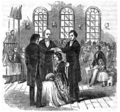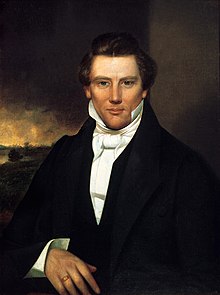Portal:Latter Day Saint movement
|
Welcome to the portal of The Latter Day Saint movement
Introduction The Latter Day Saint movement (also called the LDS movement, LDS restorationist movement, or Smith–Rigdon movement) is the collection of independent church groups that trace their origins to a Christian Restorationist movement founded by Joseph Smith in the late 1820s. Collectively, these churches have over 17 million nominal members, including over 17 million belonging to the Church of Jesus Christ of Latter-day Saints (LDS Church), 250,000 in Community of Christ, and several other denominations with memberships generally ranging in the thousands of members. The predominant theology of the churches in the movement is Mormonism, which sees itself as restoring again on Earth the early Christian church; their members are most commonly known as Mormons. An additional doctrine of the church allows for prophets to receive and publish modern-day revelations. A minority of Latter Day Saint adherents, such as members of Community of Christ, have been influenced by Protestant theologies while maintaining certain distinctive beliefs and practices including continuing revelation, an open canon of scripture and building temples. Other groups include the Remnant Church of Jesus Christ of Latter Day Saints, which supports lineal succession of leadership from Smith's descendants, and the more controversial Fundamentalist Church of Jesus Christ of Latter-Day Saints, which defends the practice of polygamy. One source estimated over 400 denominations have sprung from founder Joseph Smith's original movement. (Full article...) General images -The following are images from various Latter Day Saint movement-related articles on Wikipedia.
Selected article Mormon fundamentalism (also called fundamentalist Mormonism) is a belief in the validity of selected fundamental aspects of Mormonism as taught and practiced in the nineteenth century, particularly during the administrations of Joseph Smith, Brigham Young, and John Taylor, the first three presidents of the Church of Jesus Christ of Latter-day Saints (LDS Church). Mormon fundamentalists seek to uphold tenets and practices no longer held by mainstream Mormons. The principle most often associated with Mormon fundamentalism is plural marriage, a form of polygyny first taught in the Latter Day Saint movement by the movement's founder, Smith. A second and closely associated principle is that of the United Order, a form of egalitarian communalism. Mormon fundamentalists believe that these and other principles were wrongly abandoned or changed by the LDS Church in its efforts to become reconciled with mainstream American society. Today, the LDS Church excommunicates any of its members who practice plural marriage or who otherwise closely associate themselves with Mormon fundamentalist practices. There is no single authority accepted by all Mormon fundamentalists; viewpoints and practices of individual groups vary. Fundamentalists have formed numerous small sects, often within cohesive and isolated communities throughout the Mormon Corridor in the Western United States, Western Canada, and northern Mexico. At times, sources have claimed there are as many as 60,000 Mormon fundamentalists in the United States, with fewer than half of them living in polygamous households. However, others have suggested that there may be as few as 20,000 Mormon fundamentalists with only 8,000 to 15,000 practicing polygamy. Independent Mormon fundamentalist Anne Wilde investigated demographics and, in 2005, produced estimates that fell between the prior two sources, indicating there to be 35–40,000 fundamentalists at the time. (Full article...) Selected locationThe Nauvoo Temple was the second temple constructed by the Church of Jesus Christ of Latter Day Saints. The church's first temple was completed in Kirtland, Ohio, United States, in 1836. In the winter of 1846, when the main body of the church was forced out of Nauvoo, the church attempted to sell the building, finally succeeding in 1848. The building was damaged by arson and a tornado before being demolished. In 1937, The Church of Jesus Christ of Latter-day Saints (LDS Church) reacquired the lot on which the original temple had stood. In 2000, the church began to build a temple on the original site with an exterior that is a replica of the first temple, but whose interior is laid out like a modern Latter-day Saint temple. On June 27, 2002, a date that coincided with the 158th anniversary of the death of Joseph and Hyrum Smith, the temple was dedicated by the LDS Church as the Nauvoo Illinois Temple. (Full article...)
Selected schismatic historiesThe Church of Jesus Christ of Latter-day Saints, informally known as the LDS Church or Mormon Church, is the largest Latter Day Saint denomination. Founded by Joseph Smith during the Second Great Awakening, the church is headquartered in Salt Lake City, Utah, and has established congregations and built temples worldwide. According to the church, as of 2023[update], it has over 17.2 million members of which over 6.8 million live in the U.S. The church also reports over 99,000 volunteer missionaries and 350 temples. The church was founded as the Church of Christ in western New York, in 1830 by Smith. Under his leadership, the church's headquarters moved successively to Ohio, Missouri, and Illinois. After Smith's 1844 death and a resultant succession crisis, the majority of his followers sided with Brigham Young, who led the church to its current headquarters in Salt Lake City. Young and his successors continued the church's growth, first throughout the Intermountain West, and more recently as a national and international organization. The church has been criticized throughout its history. Modern criticism includes disputes over the church's historical claims, treatment of minorities, and finances. The church's practice of polygamy was controversial until it was curtailed in 1890 and officially rescinded in 1904. (Full article...) OutlinesRelated portalsKey biographiesJoseph Smith Jr. (December 23, 1805 – June 27, 1844) was an American religious leader and the founder of Mormonism and the Latter Day Saint movement. Publishing the Book of Mormon at the age of 24, Smith attracted tens of thousands of followers by the time of his death fourteen years later. The religion he founded is followed by millions of global adherents and several churches, the largest of which is the Church of Jesus Christ of Latter-day Saints (LDS Church). Born in Sharon, Vermont, Smith moved with his family to Western New York, following a series of crop failures in 1816. Living in an area of intense religious revivalism during the Second Great Awakening, Smith reported experiencing a series of visions. The first of these was in 1820, when he saw "two personages" (whom he eventually described as God the Father and Jesus Christ). In 1823, he said he was visited by an angel who directed him to a buried book of golden plates inscribed with a Judeo-Christian history of an ancient American civilization. In 1830, Smith published the Book of Mormon, which he described as an English translation of those plates. The same year he organized the Church of Christ, calling it a restoration of the early Christian Church. Members of the church were later called "Latter Day Saints" or "Mormons". (Full article...)
Selected image The Red Brick Store in Nauvoo, Illinois. Constructed and owned by Joseph Smith, Jr., it became a center of economic, political, religious, and social activity among the Latter Day Saints.
Did you know (auto generated)
Selected Anniversaries
Selected quote
TopicsFeatured contentCategoriesWikiProjectsAssociated WikimediaThe following Wikimedia Foundation sister projects provide more on this subject:
Discover Wikipedia using portals | ||||||||||





































